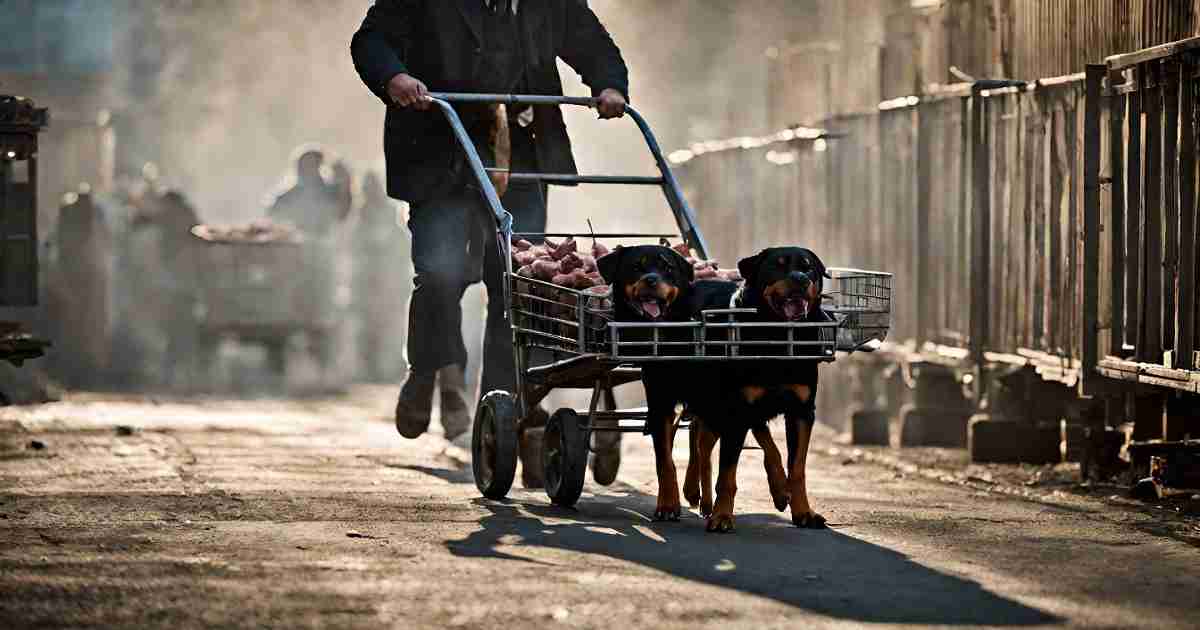The Kangal and the Rottweiler are two impressive dog breeds that are often compared due to their size, strength, and guarding abilities.
Both make loyal companions and devoted protectors, but there are some key differences between these ancient breeds.
Want to decide whether a Kangal vs Rottweiler best fits your lifestyle? Comparing these breeds’ origins, physical traits, temperaments, exercise needs, health issues, and family suitability gives great insight.
That’s exactly what this in-depth face-off aims to offer potential owners – the knowledge to make the most of choosing between these two phenomenal dogs.
Origin and History Kangals and Rottweilers
Before we contrast Kangals and Rottweilers, let’s understand where they come from. Their heritage offers clues to their natural talents and tendencies.
This early history gives insight into their natural talents and tendencies.
Kangal
- Place of Origin: Turkey
- Purpose: Livestock guardian dog to protect sheep and goats from predators
- History: Believed to be related to ancient Molosser dogs. Have served farmers and shepherds for centuries as loyal flock guardians. Their size, strength, and protective instincts made them ideal for this role.
Rottweiler
- Place of Origin: Rottweil, Germany
- Purpose: Originally used as cattle dogs and butchers’ dogs to drive livestock to market and pull carts of meat to market.
- History: Descended from ancient Roman drover dogs. Excelled as guard dogs, police dogs, service dogs, and search and rescue dogs due to their intelligence and willingness to work.
Size Comparison Between Kangal vs. Rottweiler
One of the most noticeable differences between the Kangal and the Rottweiler is their size.
- The Kangal is classified as a giant dog breed, significantly larger than the large Rottweiler.
- Typical Kangal height is 30-32 inches for males and 28-30 inches for females.
- Rottweilers stand 22-27 inches tall.
In terms of weight:
- Kangals weigh 110-145 pounds on average.
- Rottweilers tip the scales at 80-135 pounds on average.
So while Rottweilers are clearly huge, effective dogs, Kangals are in a whole exceptional class in terms of sheer large size and strength.
Physical Appearance Kangal vs. Rottweiler
Similarly to the size distinction, the Kangal and Rottweiler have distinct bodily traits that set them apart visually.
Coat and Coloration
- The Kangal sports a dense double coat, ranging from short to medium length. Colors vary from pale dun to cream hues, often with a black mask across the face.
- The Rottweiler wears the iconic black coat with rust markings in specific patterns. Their outer layer stays straight and medium length. A thinner undercoat lies beneath.
Tail
- Kangals boast a long curled tail ringing that distinctive bell shape. This helps distinguish them from other Turkish sheep guardian breeds.
- The Rottweiler’s tail is customarily docked between the 2nd and 4th joints. In countries where docking is banned, naturally long tails can occur.
Temperament and Personality Kangal vs. Rottweiler
The temperament of a dog has a huge impact on their suitability as a family pet. Here are some key personality traits of each breed:
Kangal
- Alert and observant of their surroundings
- Territorial – will defend property and livestock
- Protective instincts run deep
- Initially wary of strangers
- Devoted to family once bonded
- Intimidating presence deters intruders
- Generally aloof with outsiders
- Independent-minded yet loyal
- Gentle and playful with children in the family
Rottweiler
- Self-confident and fearless
- Obedient and eager to please the owner
- Courageous and always ready for action
- Intensely loyal and affectionate with family
- Intelligent and quick to learn
- Protective; will defend owner and property
- Devoted companions when properly trained
- Good-natured yet serious demeanor
- Loving yet dignified presence
While both have strong guarding instincts, the Kangal is more independently minded while the Rottweiler aims to please its handler.
Exercise and Training Kangal vs. Rottweiler
The exercise and training needs of each breed should be considered when choosing a canine companion.
Kangal Exercise Needs
- Require a moderate amount of exercise
- Do well when given ample room to roam safely
- Short daily walks plus access to a large fenced yard ideal
- Their exercise needs are met through patrolling territory
Rottweiler Exercise Needs
- Require at least 1-2 hours of brisk walking/jogging per day
- Enjoy activities like hiking, swimming, fetching, agility training
- Prone to obesity and joint issues if under-exercised
Training Kangals
- Independent thinkers; training requires firm, consistent leadership
- Respond best to positive reinforcement with food rewards
- Socialization is essential from early puppyhood onwards
Training Rottweilers
- Eager to learn and highly trainable
- A strong desire to please their owner fuels motivation
- Obedience training is a must; establishes you as a leader
- Use reward-based methods, not punishment
The Rottweiler is the easiest of the two breeds to train and will readily respond to commands. Kangals can be trained, but require patience and persistence.
Grooming Needs Kangal vs. Rottweiler
In terms of grooming, the Kangal and Rottweiler are relatively low-maintenance breeds.
- Their short to medium coat length does not require intensive brushing.
- Occasional brushing (1-2 times per week) will remove dead hair.
- Both breeds are average shedders. They blow their coats once or twice per year.
- Bathing only when necessary – over-bathing can dry out the skin.
- Check ears for infection, and trim nails regularly.
- Brush teeth frequently for good dental health.
Neither the Kangal nor Rottweiler requires regular trips to a professional groomer. Their grooming needs can easily be met at home with routine brushing, bathing, and other basic care.
Kangal vs. Rottweiler bite force:
The bite force refers to the pressure a dog’s jaws can apply when biting down. Strong bite force can be an asset for dog breeds used in guarding and protection roles.
When comparing the bite strength of the Kangal versus the Rottweiler, there are a few key points to consider:
- Kangals have a significantly larger bite force. It is estimated to be over 700 PSI (pounds per square inch), one of the highest in the dog world. Their huge size contributes to jaw power.
- Rottweilers have a bite force of around 328 PSI, based on various research studies. This is on par with other muscular, big-jawed breeds like Pit Bulls and German Shepherds.
- The PSI number only tells part of the story. Rottweilers have very strong neck muscles that add shaking and crushing power to their already substantial bite.
- Bite inhibition training is important for both breeds when interacting with humans to control biting strength.
- Proper socialization reduces the risk of unwanted biting in response to perceived threats.
- Responsible ownership and training are required for both Kangals and Rottweilers to manage their guarding instincts.
While the Kangal’s bite force potential significantly exceeds the Rottweiler’s due to its sheer size and strength, both breeds have impressively powerful jaws. However, bite strength should never be used as a singular measurement of a breed’s suitability or risk level as a family companion.
Kangal Shepherd Dog vs Rottweiler:
- Kangals are much larger and more powerful than Rottweilers. Kangals have a stronger bite force, estimated at over 700 PSI compared to 328 PSI for Rottweilers.
- Rottweilers are easier to train and more people-oriented. Kangals are more independent and aloof.
- Both breeds have strong protective instincts and make loyal guardians.
Kangal vs Dogo Argentino vs Rottweiler:
- Kangals are the largest of the three, with Dogos second and Rottweilers smallest.
- Dogs were bred for big game hunting and have a very high pain tolerance.
- Rottweilers are the most eager to please and trainable. Dogs can be stubborn.
- All three need extensive socialization to curb aggression.
Who is stronger, Kangal or Rottweiler?
- Kangals are significantly stronger due to their much larger size. They can weigh up to 145 lbs compared to 135 lbs for Rottweilers.
- Kangals have a bite force of over 700 PSI, more than double a Rottweiler’s 328 PSI.
- Kangals are one of the world’s strongest dog breeds in terms of their size and muscle power.
Feeding and Nutrition
Proper nutrition is vital for any dog breed. Here are some feeding considerations for Kangals and Rottweilers:
- Both breeds are prone to overeating if given the chance
- They should be fed measured meals rather than free-fed
- 2-3 cups of quality dry dog food per day is typical, but follow label guidelines
- High protein diets support muscle growth and development
- Avoid low-quality fillers; opt for meat as the first ingredient
- Obesity can put excessive strain on joints. Overweight dogs have a higher incidence of hip and elbow dysplasia.
- To promote good bone health, ensure food has proper calcium and phosphorus levels.
- Always provide a fresh, clean source of drinking water.
Owners of both breeds must monitor intake and weight, feeding a nutritious diet at appropriate portions to avoid obesity.
Health Issues Kangal vs. Rottweiler
All dogs have certain health issues their breed may be prone to. Being aware of these can help owners provide preventative care.
Common Kangal Health Issues
- Hip and elbow dysplasia – malformed joints. Can cause arthritis later in life.
- Bloat – potentially fatal twisting of the stomach. Requires immediate treatment.
- Eye problems such as entropion, ectropion, and progressive retinal atrophy.
Common Rottweiler Health Problems
- Hip dysplasia – abnormal hip socket development leading to arthritis.
- Elbow dysplasia – abnormal growth of elbow joints.
- Osteosarcoma – aggressive bone cancer often involving limbs.
- Gastric dilatation volvulus (bloat) – an emergency condition requiring fast treatment.
Reputable breeders will test breeding dogs for dysplasia and eye conditions to minimize passing these issues to puppies. Some conditions like cancer cannot be screened for but regular vet check-ups help detect any emerging issues.
Guarding and Protection Instincts
Both the Kangal and Rottweiler descend from centuries of work as guardian dogs protecting livestock and property. This means their guarding instincts emerge naturally but must be properly directed.
- Both breeds exhibit wariness towards strangers if not well-socialized.
- They have strong territorial instincts and a deep bark that deters intruders.
- Owners must curb any unwanted aggression through training and socialization.
- Early obedience training establishes the owner as the leader who gives direction.
- When properly supervised, both breeds’ protective nature is an asset, not a liability.
Responsible management of Kangal and Rottweiler guarding tendencies is essential for anyone considering these breeds. With guidance, their natural skills can be harnessed effectively.
Family Companion Suitability Kangal vs. Rottweiler
How suitable is each breed for family life? Let’s compare.
Kangals
- More aloof than Rottweilers; bond primarily with one owner
- Need extensive socialization to accept strangers
- Do best with older children who understand dog behavior
- Can be wary and suspicious around visiting friends
- Require supervision around young kids due to size
- Tend to be serious; not given to playfulness in adulthood
Rottweilers
- Form very close attachment and bond with family
- Devoted and affectionate with all members
- Excellent companions for responsible kids
- Make faithful watchdogs but not attack dogs
- Adaptable and people-oriented if properly trained
- Remain playful and silly well into maturity
For families with children, the Rottweiler’s loyalty, eagerness to please, and retained playfulness give them an edge over the more reserved Kangal. Proper introductions and training help ensure both breeds coexist safely with kids.
Breeder Selection
Finding a responsible breeder is crucial when acquiring a Kangal or Rottweiler puppy. Warning signs of an unethical breeder include:
✘ Breeding dogs at every heat cycle for maximum puppy production
✘ Keeping breeding dogs in poor conditions
✘ Not providing vet care or immunizations
✘ No genetic or hip testing of parents
Reputable breeders will:
✔ AKC, UKC, or breed club registered
✔ Focus on health and temperament over appearance
✔ Have the parent’s hip tested and cleared for dysplasia
✔ Provide vet-checked pups with immunization records
✔ Interview prospective owners to ensure suitability
✔ Take dogs back if owners can’t keep them
Doing your homework to identify responsible Kangal or Rottweiler breeders is time well spent to get a happy, healthy pup.
Adoption and Rescue
For many, adopting an adult Kangal or Rottweiler can be a rewarding alternative to getting a puppy. Consider if this option fits your situation:
Benefits of Adopting
- Adult personality already established
- The adoption fee is far less than the puppy price
- Gets dog out of shelter situation
Things to Consider
- May have hidden behavioral or health issues
- May need training in manners and obedience
- Less lifetime with an adopted adult dog
Ways to Find an Adoptable Kangal or Rottweiler
- Check local shelters, rescues, Petfinder.com
- Search Kangal or Rottweiler breed Facebook Groups
- Google “(Your city) Kangal/Rottweiler rescue”
For the right owner, adopting a mature dog of either breed can be very fulfilling. Be prepared for potential transition challenges as the dog settles into your home.
Frequently Asked Questions
Q: Are Kangals better guard dogs than Rottweilers?
A: Kangals do have stronger territorial instincts and a more imposing presence that serves as a deterrent.
But well-trained Rottweilers also make excellent guard dogs due to their protective nature, courage, and obedience.
For most families, Rottweilers are the preferable choice as they form a close bond and are easier to manage.
Q: Which breed sheds more hair?
A: The Kangal and Rottweiler shed a moderate amount year-round. Kangals “blow” their coat once or twice annually which leads to heavier seasonal shedding.
But Rottweilers also shed more heavily during seasonal coat blowing. Overall shedding levels are similar.
Q: Which breed is easier to train?
A: Rottweilers are the easiest of the two breeds to train. They aim to please their owners and respond readily to obedience training when taught using rewards-based methods.
Kangals are more independent-minded and can be stubborn, requiring extra patience and firm, consistent handling.
Q: Which breed has higher exercise needs?
A: Rottweilers have higher exercise requirements than Kangals. They need at least 1-2 hours of brisk walking or jogging per day. Kangals are lower energy and do well with access to a yard plus shorter daily walks.
Q: Is a Kangal or Rottweiler better with kids?
A: When properly socialized and trained, Rottweilers tend to be the better breed for families with children.
They form tight bonds with family members and adore kids. Kangals are more aloof, serious, and wary of outsiders, including children. Supervision is still recommended with both breeds.
Q: What are some common health problems in each breed?
A: Common health issues to be aware of are hip and elbow dysplasia, eye conditions, and bloat susceptibility in both breeds. Kangals can also develop hypothyroidism. Rottweilers have a higher incidence of osteosarcoma bone cancer.
People also ask:
Which dog breed can defeat Kangal?
While Kangals are imposing guard dogs, no one breed definitively “defeats” them. Potential breed matches like the Caucasian Shepherd Dog or Tibetan Mastiff have the size and strength to challenge a Kangal. Much depends on each individual dog’s health, training, and temperament.
Which dog breed can beat Rottweiler?
Some breeds like the Kangal and Alabai that are both larger and stronger than a Rottweiler may be able to physically overpower one in a fight, which is never recommended.
But in terms of working ability, intelligence, and trainability, a well-bred Rottweiler holds its own against any breed.
Is the Kangal the toughest dog?
The Turkish Kangal is considered one of the toughest dog breeds due to traits like its large size, bite force of over 700 PSI, protective temperament, and ability to handle extreme cold temperatures.
However, “toughness” cannot easily be measured, and other breeds like the Caucasus Shepherd and Tibetan Mastiff can also lay claim to the title.
Would a Kangal beat a pit bull?
Who’s to say for sure? So much depends on the individual dog – their health, training, and personality. Physically speaking, the much larger Kangal likely has the advantage in a knock-down fight.
But we can’t underestimate the Pit Bull’s gameness and powerful bite either. At the end of the day, no responsible owner should ever purposefully pit their dogs against each other. That benefits no one, least of all the dogs.
Conclusion
Both emerging from a long heritage as guardians of livestock and property, the Kangal and Rottweiler share certain traits – strong protective instincts, imposing size, and muscular strength.
Make no mistake though – notable differences exist between the breeds too. Energy levels, temperament tendencies, family suitability – the comparison highlights key contrasts.
So what’s the right choice for you and your lifestyle? Carefully reflect on your experience and home life as you weigh the noble Kangal against the stalwart Rottweiler.
Whichever breed you welcome into your life, upholding responsible ownership practices will ensure a long and happy union.









